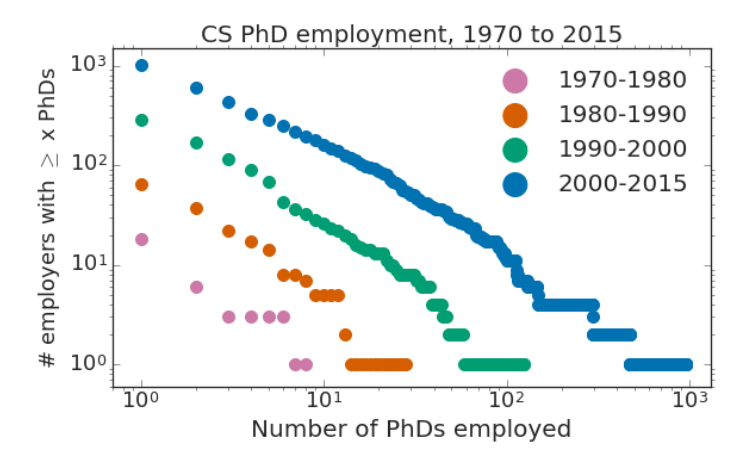Study maps careers of CS PhDs using decades of data
The researchers identified movement between industry, academia, and government work, tracked the growth of important organizations, and built predictive models for career transitions and employer retention.
Of the many burning questions in the world of computing research, the one most dear to a student’s heart has typically been the least investigated: what happens after a PhD in computer science?
Prof. Danai Koutra and CSE PhD student Tara Safavi set out to provide the world’s first data-driven answer, analyzing several decades of post-PhD computing careers using a large new dataset rich with professional information. From their findings, they developed a career network model, called R3, that captures the dynamics of computing careers over time.
The researchers used the HITS link analysis algorithm in conjunction with R3, making this the first application of HITS to a study on career trajectories. Together, these tools helped them draw conclusions about both individuals and organizations in computing research. With R3, the researchers identified movement between industry, academia, and government work, tracked the growth of important organizations, and built predictive models for career transitions and employer retention.
System-wide evolution
The study reveals key organizations, from startups to universities to industry leaders, in computing research history. R3 captures factors beyond size and popularity that contribute to organizational “importance,” demonstrating that some organizations are important precisely for their small size, low retention, or short existences. The researchers were able to identify a variety of “hubs” and “authorities” over time, the former producing expertise that moved to other organizations and the latter attracting it. Some large companies with lots of researcher movement in and out qualified as both, such as IBM and Microsoft.

 Enlarge
Enlarge
Cross-sector career movement
The researchers examined post-PhD career transitions across sectors. Beyond finding evidence that cross-sector collaboration is increasing, R3 reveals that there’s truth to the narrative that it’s easier to break into industry from a different sector (especially academia) than vice versa. They also find that PhDs transitioning from industry appear to gravitate toward more “prestigious” institutions than their current industry employers, while those transitioning to industry often move into startups.

 Enlarge
Enlarge
Individual retention prediction
The researchers were able to predict career transitions by combining R3 network dynamics and individual career trajectory information. The study demonstrated that R3 could be of immediate use to recruiters hoping to retain PhDs in computing. It was also able to identify which organizations have been more successful in retaining talent, as well as how much “employee expertise” tends to move around between organizations.

 Enlarge
Enlarge
“This work is a starting point for large-scale studies of computing career trajectories,” the researchers say in their findings. “Such analyses are becoming crucial as demand for computing expertise grows and our world increasingly depends on research innovations in computer science.”
This project opens up many opportunities to take the study deeper. Future investigations could tackle broader data, capturing the many important researchers with PhDs from other countries or without PhDs at all. Insights can also be gleaned by comparing different sub-groups in the field, like researchers from different continents or countries, those with or without a postdoc, and historically underrepresented groups in computing.
The paper, titled “Career Transitions and Trajectories: A Case Study in Computing,” will be published at KDD 2018.
 MENU
MENU 
